The ZH230 is a stereo vacuum-tube amplifier that uses the output transformerless ZOTL technology (US Patent 5,612,646). The ZH230 uses moderately high bias currents in the output tubes compared with some Berning products. This is possible because of the lower power of the amplifier. The ZH230 is designed for loudspeaker loads ranging from 4 Ohms to 16 Ohms, and can be operated without a load. Single-ended RCA type inputs and binding post outputs are provided.
The ZH230 is designed to accept various tube-type combinations, and will auto-bias itself for these combinations. The ZH230 is shipped with a medium-high-gain tube combination. These include a 12AX7 for the first stage and a 12AU7 for the second stage. The 33JV6 output tubes cannot be changed to different types. This combination provides a medium amount of feedback and one-ohm output impedance for moderately high speaker damping.
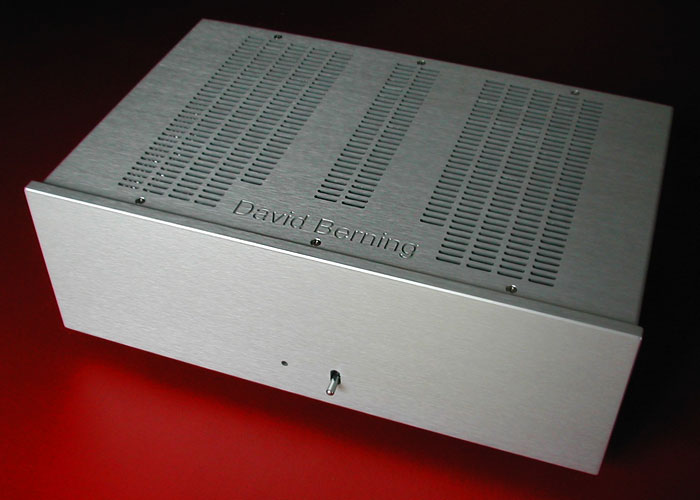
Often it is desirable to change the speaker damping to obtain a more natural sound. The impedance of many speakers varies with frequency, and often this shows up most dramatically with a rise in impedance near the bass resonance frequency. A tube change can be used to reduce or increase the feedback and thus raise or lower the output impedance of the amplifier, and this affects the system frequency balance by coupling more or less power into the speaker at those frequencies where the impedance is higher. Speaker designers generally try to design for a flat frequency response using an anechoic chamber. Home listening environments generally fall far short of the ideal acoustic properties of the anechoic chamber, and the ability to change feedback gives you, the amplifier user, a means to modify the normal speaker response to compensate for room acoustics and personal preference.
Technically, speaker damping relates to the control that the amplifier has over the position of the speaker diaphragm. High damping applies tighter voltage control over the speaker and causes the amplifier to absorb and stop speaker cone motion due to the speaker cone overshooting its desired position in response to transients. However, many speakers are somewhat over damped by design and rigid voltage control is not optimum. Lower feedback in the amplifier reduces the tightness of the voltage control and applies a mixture of current and voltage control. If the speaker is over damped, the cone will not reach its proper position quickly in response to a transient. With the right amount of damping, the speaker cone will neither overshoot nor undershoot its desired position. This is often termed critical damping. High damping is likely to give a tighter, dryer, and more analytical sound, and low damping is likely to give a more open and resonant sound. The sonic attributes of damping show up most dramatically in the bass.
The Proven ZOTL Technology, Now in the ZH230
The design of the Berning ZH270 power amplifier represented a radical departure from that of other amplifiers. The ZH270 was the first amplifier using all-tube amplification to properly match the high-voltage, low-current operating parameters of vacuum tubes to the low-voltage, high-current drive requirements of dynamic loudspeakers without using audio-output transformers. The technology is detailed in Berning US patent 5,612,646, and a simplified overview is given below. The ZH270 has gained much respect for its transparency, versatility, and reliability, and had enjoyed a production run of over 10 years. The ZH technology has also proven itself in other recent Berning products as well.
Audio-amplifier design engineers have long sought to eliminate the audio-output transformer because of the restrictions that it has always imposed on amplifier performance. Both leakage inductance and interwinding capacitance limit the high-frequency response of the transformer, while core saturation and magnetizing current limit its low-frequency response. Transformer-core hysteresis causes certain kinds of distortion of the non-symmetric and transient waveforms so characteristic of musical reproduction.
Tube Amplifiers have been previously made that drive dynamic loudspeakers without output transformers. These amplifiers are called output-transformerless (OTL) amplifiers. A well-known pioneer of this type of amplifier was Julius Futterman, and there have been many amplifiers made by various companies over the years that are based on the Futterman principles. The Futterman design incorporates two separate banks of parallel-connected tubes. The two banks are joined in series by connecting the effective cathode of one tube bank to the effective plate of the other tube bank, and driving the loudspeaker in a push-pull fashion from this junction point directly without a transformer. Popular alternatives to the Futterman use low-impedance triodes, but the basic principals are the same. Given a sufficient number of parallel-connected tubes in each bank, enough drive current can be obtained to drive the speaker.
There are several problems associated with the OTL amplifier that have limited its application. The OTL amplifier is a "brute-force" methodology, whereby the banks of tubes are forced to deliver the required drive-current by high-feedback techniques. The natural impedance of the cathode "push" is much lower than the plate "pull", and neither one is anywhere near the actual speaker impedance. In the Futterman amplifier, a large amount of negative feedback is required to force the push and the pull to work together properly, and to provide sufficient damping for the speaker. Some of the alternative OTLs that use the low-impedance triodes can operate without requiring feedback because the gain of these triodes is so low that there is little difference between the plate impedance and the cathode impedance, so the mismatch between the push and the pull is minimal. However, even with the lowest impedance triodes available, there is still a basic impedance mismatch between the tubes and the speaker in the OTL circuit. The success of mating OTL amplifiers to dynamic speakers is very dependent on the characteristics of individual speakers. Major reliability issues surround OTL amplifiers, not only because a large number of power tubes are required, but also it is necessary that the tubes need to be driven hard to obtain the required output current. Power consumption is high for OTL amplifiers, often exceeding one kilowatt for a stereo pair. Noisy fans may be needed in these amplifiers. Additional room air-conditioning may be needed, further increasing the listening-room noise level.
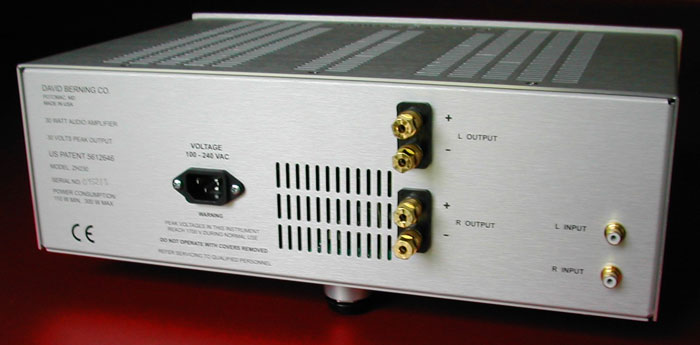
The Berning ZH amplifiers take advantage of new technology in order to eliminate the audio-output transformer. These amplifiers use radio frequency to change the voltage-current transfer characteristics of the output tubes from their normal impedance-plane to one suitable for driving a dynamic loudspeaker. The radio frequency re-mapping is implemented using special high-frequency power conversion techniques. The high-voltage, low-current tube impedance-plane is re-mapped to the high-current speaker impedance-plane through a special transformer at a constant RF carrier frequency of 250 kHz (500 kHz for the ZH230). Because the audio signal is riding on a carrier, it is not subject to parasitic elements of the transformer that would otherwise distort the audio signal. There is no low-frequency limit for this impedance conversion, and these amplifiers are dc-coupled, with the exception of a small, high-quality, dc-blocking capacitor at the input of the amplifier to prevent the amplification and application to the speaker of any dc that might be present at the input.
The impedance matching in the ZH amplifier is precisely determined by the effective turns ratio of the RF conversion transformers. Both the push and pull portions of the amplifier are handled in a symmetric fashion, as they are in a conventional transformer-coupled amplifier, and negative feedback is not required to force the positive-output current capability to be similar to the negative-output current capability.
Audio-output transformers have a limited impedance conversion range imposed by the parasitic elements. Audio-output transformers also have limits imposed by voltage breakdown between primary and secondary, and required insulation also affects the parasitic elements adversely. It is difficult to make a high-fidelity transformer with much more than a 25:1 overall primary-to-secondary turns ratio for the above reasons. These restrictions are eliminated in the ZH amplifiers, and larger effective overall turns ratios are applied to use the tubes more efficiently than they can be with the smaller ratios. One implication of this change is that the reflected plate resistance of the output tubes is lowered, making the tubes appear more like triodes to the speaker.
Another implication of using a higher-effective turns ratio is that the output tubes operate at lower current and higher voltage than they otherwise would. As tubes become weak with age, the current capability is reduced, but the voltage capability is not affected. Longer useful tube life is expected because less current is required for a given output power. The opposite situation applies to the traditional OTL amplifier.
Audio-output transformer-coupled amplifiers should not be operated without a load connected because the inductance of the transformer's primary can cause the plate voltage to reach a sufficiently high voltage to break down insulating materials, resulting in amplifier failure and even fire. Some amplifiers are even unstable without a load. Unlike output-transformer-coupled amplifiers, the ZH amplifiers can be operated safely without a load, as the voltage cannot exceed its normal designed-in operating voltage.
Other Features and Specifications
Like other recent Berning products, the ZH230 incorporates a fully regulated, resonant-type, switching power supply. The use of regulated switching power-supplies in Berning amplifiers over the years has resulted in these amplifiers obtaining a reputation for having better control in the bass than tube amplifiers with conventional power supplies. The use of these supplies has also resulted in unusually lightweight and compact amplifiers for their power capability because there was no line-frequency power-transformer in these units.
The ZH230 follows other Berning designs in that the tubes are operated at relatively low temperatures for long life. The idle plate-dissipation for the 33JV6 output tubes is 7.5 W each, and their heaters are operated below their normal rated voltage. Routine tube replacement on the ZH230 should not be needed with normal usage, and 10,000-hour lifetime should be expected. It is recommended that the ZH230 be powered down when it will not be used for several hours or more, otherwise it can be left powered.
The audio circuit board in the ZH230 is a special low-loss ceramic material and provides for the amplifier having a more transparent sound with additional presence. The ZH230 is also equipped with Stillpoints TM OEM Universal Resonance Dampers.
Other features and specifications include:
- All balanced amplification.
- No phase compensation for feedback used.
- Constant output impedance over entire audio spectrum.
- Built-in five-stage power-line filter and surge suppressor.
- Non-magnetic chassis prevents skin-effect induced distortion.
- Power consumption: idle-110 W; max-300 W. Power factor corrected.
- Line voltage required: (universal) 100-240 VAC, 50-440 Hz.
- Signal to noise: broadband (typical) 60 dB, all feedback settings. 20 kHz bandwidth (typical): 85 dB to 105 dB, depending on tube complement. All figures unweighted.
- Distortion (typical, at 8 ohm loads at 30 W): 0.3 % to 0.7 % These double at 4 ohms.
- Typical output power at onset of clipping: 8 ohms 36 W; 4 ohms 36W.
- Frequency response at 5 W, 8 ohms: +0, -0.6 dB @ 30 kHz.
- Frequency response at 5 W, 4 ohms: +0, -2,7 dB @ 30 kHz, +0, -1.5 dB @ 20 kHz.
- Low frequency limit: 0 dB down @ 20 Hz, but repetitive waveforms into 4 ohms below 20 Hz activates speaker protection.
- Typical output impedance (measured at 1 amp, 60 Hz): 0.6 Ohms to 2.7 Ohms, depending on tube complement.
- Sensitivity at 30 W output: 8 ohms: 0.4 V RMS to 0.75 V RMS, depending on tube complement and load impedance.
- Input impedance: 50 kOhm
- Size: 42 cm wide, 30 cm deep, 17 cm high, (16.5 X 12 X 6.75 inches), including connectors and feet.
- Net weight: 7 kg (15 lb); Boxed, 9 kg (20 lb).
- Finish: silver anodize
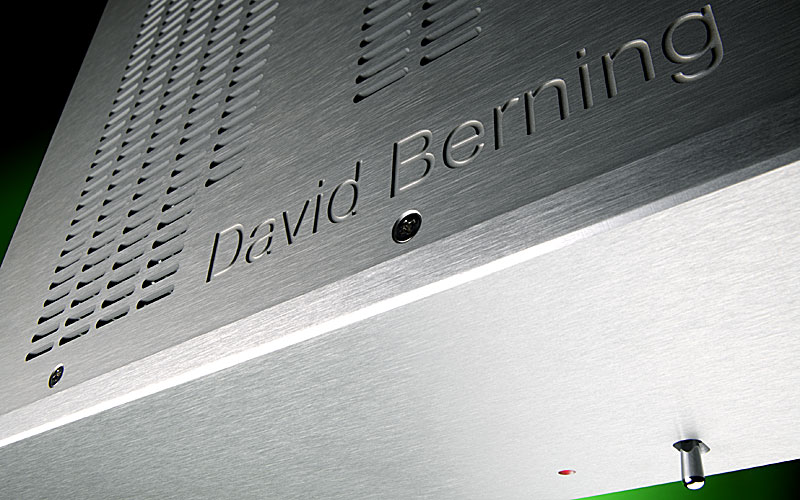
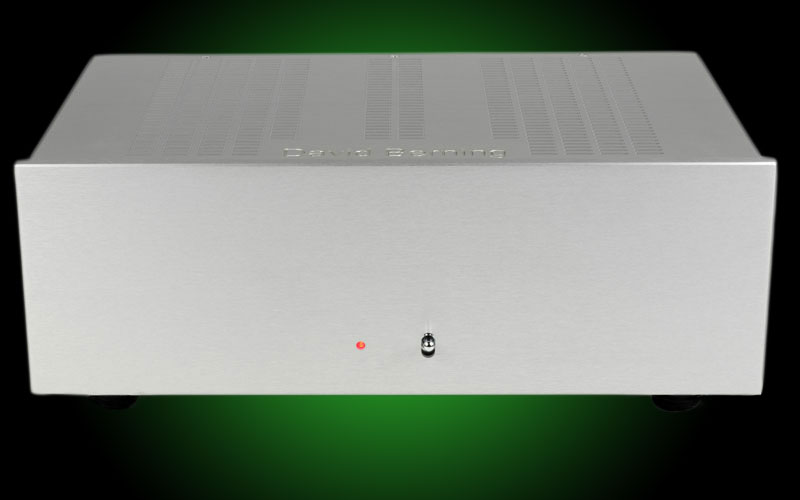
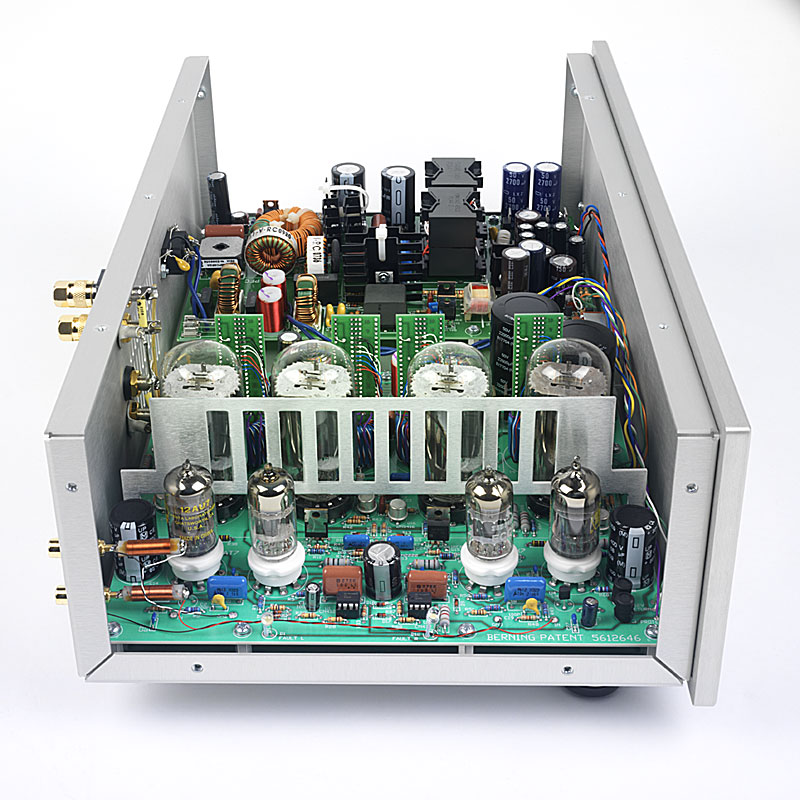
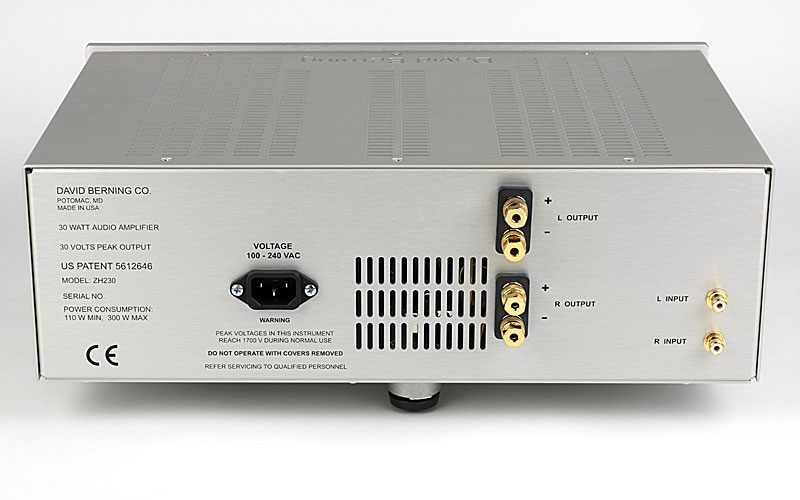
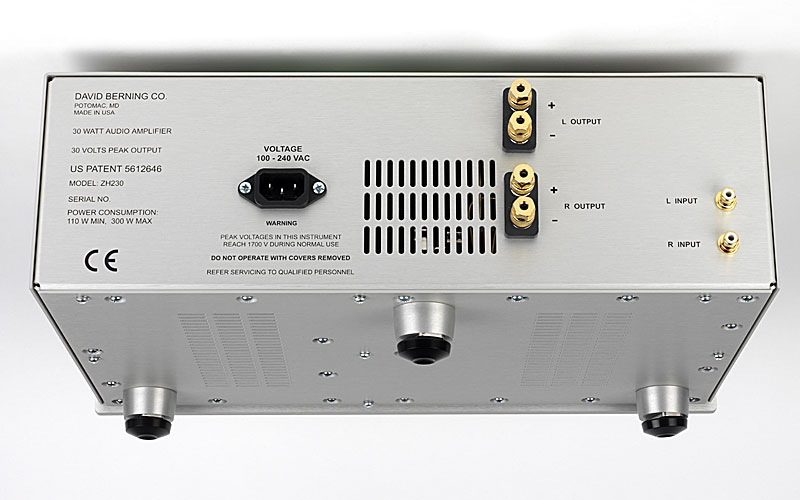
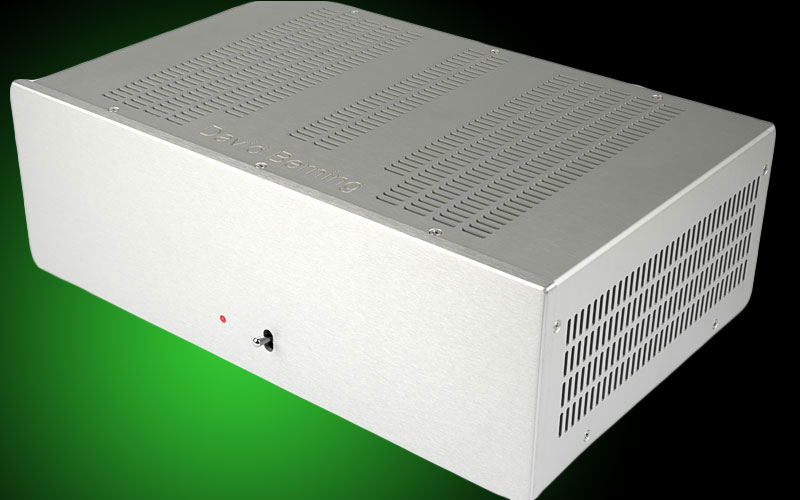
"Harmonically sophisticated"
Soundstage Ultra reviews the Berning ZH-230 Stereo Amplifier
"Many manufacturers claim that their products are 'innovative,' but few merit that description more than the amplifiers designed by David Berning. ...
"When the Berning arrived, I was reviewing a pair of speakers that sounded decent. The ZH-230 transformed them into speakers that sounded seriously good. The bass was now supercharged, with considerably more extension and weight. I ended up swearing a lot as I put this amp through its paces, saying things like "I can't believe this amp sounds this @#%&* good! ...
The ZH-230 "...delivered power right now. That speed made it the most effortlessly dynamic-sounding amplifier I've ever heard, and it seemed much more powerful than its rated output. Heck, it sounded more dynamic than my Audio Research VS115, which puts out 115Wpc to the Berning's 30Wpc. And it wasn't just the ZH-230's ability to play loudly -- the microdynamic changes within musical passages that constitute a musician's phrasing were somehow more clearly defined than with most other amps I've heard. There was a sense of unlimited dynamic reserve -- as if every other amp I've heard has been dynamically compressed. But I don't think those amps were actually compressed -- I think they were slow. I can't emphasize enough how the ZH-230's dynamic agility enhanced the music played through it. And I don't mean just a few orchestral blockbusters; it applied equally to every album I listened to. Dynamics are a huge part of music, and doing them better makes the music sound better. ...
"And as the musicians' musical lines ebbed and flowed, the Berning's microdynamic capabilities made these continuous variations in their instruments' volumes very easy to follow. When an amplifier reproduces the most fleeting volume changes, you hear more of the performers' intent. That's what high-end audio is all about....
"...the ZH-230 realistically presented tonality in time and space -- instruments sounded right. ... The ZH-230's instantaneous dynamics benefited ... lightning-fast dynamic swings. I seem to be saying that a lot. ...
"I was totally smitten by the David Berning Company's ZH-230. It solves some of the significant drawbacks of tube amplifiers -- short tube life, heavy weight, limited bandwidth -- while retaining the tonal luminosity, detail, and smoothness for which tubes are prized. Its ability to provide almost instantaneous power made it sound more powerful than its rated output. ...
"As a reviewer, I get to audition a fair number of amplifiers ... the Berning ZH-230 is the best I've ever heard. ... what counts is that the ZH-230 made music sound right. For me, that meant it was more fun to listen to music with the Berning ... David Berning's ZH-230 has made it very hard for me to listen to other amplifiers."
The Absolute Sound Magazine TAS210, by Dick Olsher
"...the ZOTL is in reality an emulation circuit for an ideal output transformer. It matches impedance just like a transformer, and it is a two-way communication between tubes and speaker as is a conventional transformer. The beauty of it is that the ZOTL does not suffer from the frequency-dependence issues of a transformer... the two-way communication is a critical design feature. This is the thing that separates the ZOTL from a hybrid amplifier. The ZOTL should not be considered a tube amp followed by some other kind of output buffer -- it is not. By having the two-way communication, the speaker is fully controlled by the output characteristics of the tubes, and that includes all-important damping. This is not the case with the hybrid amplifier that is simply tubes with an output buffer.
"...a new product introduction from the creative mind of David Berning is an event, a happening if you will. His designs are far from being yet another twist on a 1950s circuit, which to be perfectly honest is what most of tube audio is all about nowadays... It represents David Berning's severing of the Gordian Knot that is a conventional audio output transformer..."
"The overall presentation possessed a refreshingly low-distortion signature -- no tube brightness or glare to complain about. Harmonic colors shone vividly while textures were consistently sweet sounding, smooth, and totally grunge- and grain-free. The harmonic envelope of a solo instrument ebbed and flowed in a relaxed, effortless manner, with richness of tone. By extension there was plenty of low-level detail to behold. But it was all very discreet, without the cheap trick of etching treble transients.
"This is one of the few power amps I can easily carry under my arm. That can be explained not only by the lack of a conventional output transformer but also by the absence of a power transformer. There's no heavy iron here. The power supply is a switching type and incorporates a five-stage power-line filter and surge suppressor. The amplification circuitry is fully balanced... Since the ZH-230 is auto-biasing, these tubes may be changed without having to worry about manual bias-calibration... Since the idle-plate dissipation of the power tubes is only 7.5W and their heaters are operated below the rated voltage, their expected lifetime, according to Berning, is 10,000 hours.
"The Berning ZH-230 is the one, the anointed new king. It represents in my estimation the state-of-the-art in medium-power amplification. Let no one doubt the sonic potential of ZOTL technology. It delivers a substantial dose of tube magic while avoiding the pitfalls of tube euphonics and textural hyper-liquidity that afflict so many conventional tube amps. Its sound is rich, luxuriant, and dramatic, with a winning combination of transient speed and immediacy. A must audition for anyone serious about reproduced music.
"A natural consequence of a steady exposure to a particular medium is blind acceptance of the underlying paradigm, including all of its limitations...what I found instantly startling about the ZH-230 was its superlative transient speed at the point of attack. By contrast, conventional transformer-coupled tube amps appear to round off the leading edge, making transients appear softer...than the real thing... Mellow may be fun, but to my mind, the ZH-230 is a game-changer... It's a considerable gift, combining...the best of tube and transistor sound. Control of transient decay was also exemplary. Treble nuances were silky smooth and delicate, yet never aggressive or in your face...
"The other attribute that set the Berning apart from the crowd was its immediacy -- a lack of veiling that created a strong sensation of being able to reach out and touch image outlines. This combination of speed, control, and immediacy resulted in ... a cohesive, spacious, fully 3-D soundstage with excellent transparency and fabulous image palpability...
"In particular, the midrange was most compelling, being pure and dynamically nuanced. The timbre of both male and female vocals was right on...Overall, this was the sort of sound that was felicitous...and could be enjoyed till the cows came home.
"...[in reproduction of bass] the ZH-230 exhibited convincing pitch definition and was capable of thunderous bass output and of fleshing out a convincing orchestral foundation. In particular, the lower mids were characterized by a realistic tonal authority. Quickness in the bass range was at least partly responsible for considerable rhythmic drive, really a prerequisite for toe-tapping musical involvement. Recordings high on boogie factor were propelled forward with a huge kinetic impulse. Microdynamic nuances were given full scope of expression...
New York Audio & AV Show, April 2012
"...this system kicked all manner of ass. The sound was delicate and finessed. ...the sound went deep, played cleanly, and had tremendous extension. When the music called for grace, there was grace. When the music called for balls, well, yeah. Uh huh... The imaging was freaky-precise, with spectacular depth and width. What a sound stage! ...the Berning gear was stunning. I couldn't stop ogling. ... My favorite system of the show by far. This one blew me away."
New York Audio & AV Show 2012
"...A new deck for most people (myself included) was the Holborne, a minimalist Swiss-made Pd.5,275 Analog 2 turntable with matching $3,475 turntable and a made-for-Holborne Benz-derived moving coil cartridge for just under $2k. Driven by a belt made of magnetic tape, the deck was sounding intriguing in a Berning pre/power (with the new 60w mono versions of the ZH-230), driving a pair of prototype versions of the Zellaton Concert, using Tellurium Q cables once again. The room...had distinct touches of greatness about it. As in, this was warming up to be one of the best sounds I've heard at a show. Perhaps any show."